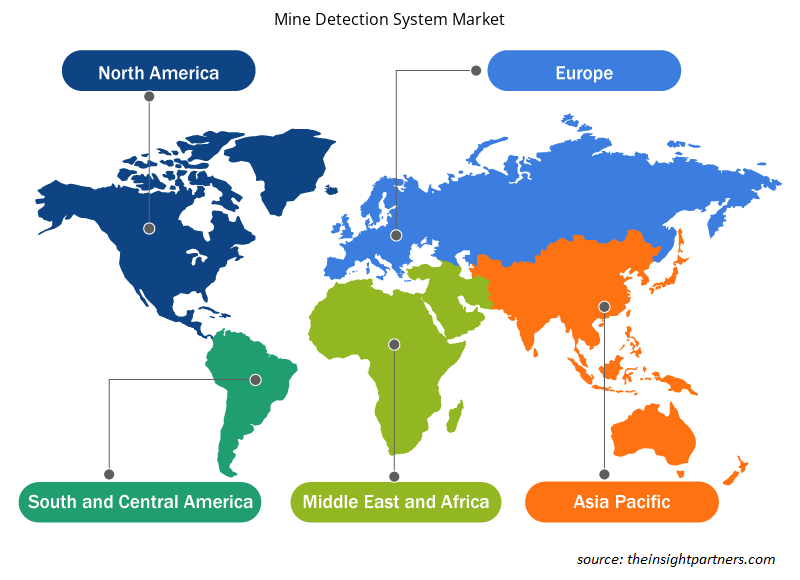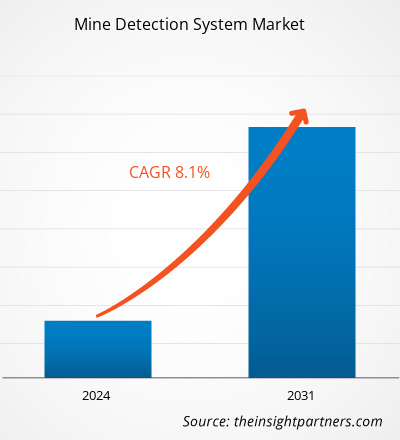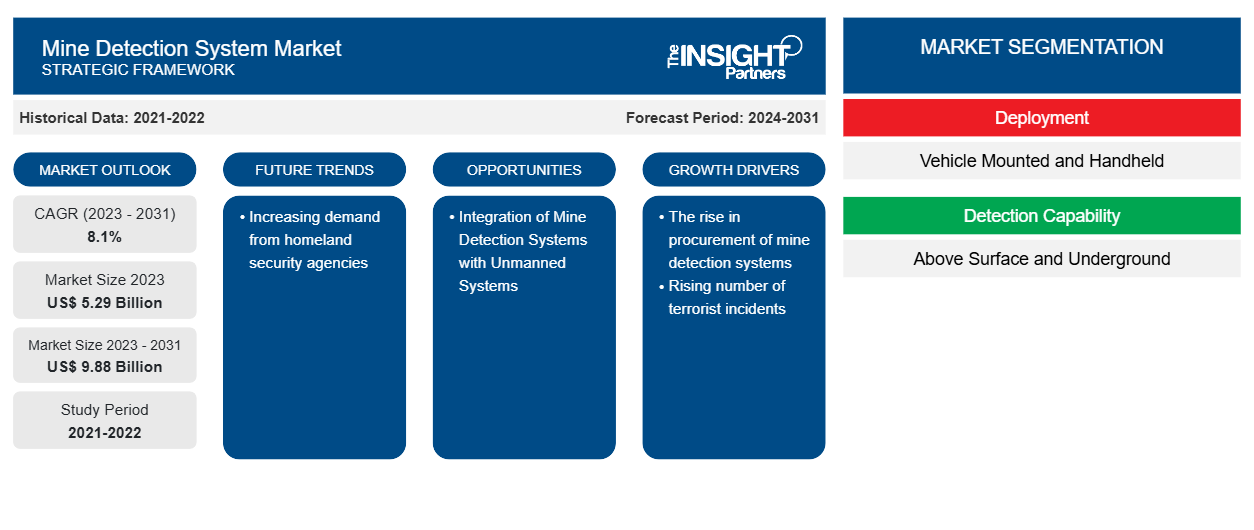Der Markt für Minenerkennungssysteme soll von 5,29 Milliarden US-Dollar im Jahr 2023 auf 9,88 Milliarden US-Dollar im Jahr 2031 anwachsen. Der Markt wird zwischen 2023 und 2031 voraussichtlich eine durchschnittliche jährliche Wachstumsrate von 8,1 % verzeichnen. Die steigende Nachfrage der Heimatschutzbehörden dürfte ein wichtiger Trend auf dem Markt bleiben.
Marktanalyse für Minenerkennungssysteme
Minensuchsysteme gehören zu den Produkten, die bei den Verteidigungs- und Heimatschutzkräften stark nachgefragt werden. Dies liegt an der Bedeutung der Systeme für die Sicherheit eines Landes. Die Verteidigungskräfte verlassen sich stark auf die etablierten Akteure auf dem Markt für Minensuchsysteme. Die höhere Abhängigkeit von den großen Verteidigungsunternehmen spiegelt die höhere Anzahl der an diese Unternehmen vergebenen Aufträge wider. Aus diesem Grund ist der Markteintritt für kleinere oder regionale Akteure auf dem Markt für Minensuchsysteme eingeschränkt. Dieser Faktor wurde analysiert, um die Bedrohung für neue Marktteilnehmer im Bereich der Minensuchsysteme zu verstehen.
Marktübersicht für Minenerkennungssysteme
Zu den wichtigsten Akteuren im globalen Ökosystem des Marktes für Minensuchsysteme gehören Komponenten, Hersteller von Minensuchsystemen und Endnutzer. Lieferanten von Komponenten für Minensuchsysteme liefern Produkte wie elektromagnetische Sensoren, Radare, optische Sensoren und thermische Erkennungssysteme. Jede Unterbrechung der Komponentenversorgung wirkt sich negativ auf die Produktion des Endprodukts aus. Daher spielen die Komponentenhersteller eine entscheidende Rolle im Ökosystem des Marktes für Minensuchsysteme.
Passen Sie diesen Bericht Ihren Anforderungen an
Sie erhalten kostenlos individuelle Anpassungen an jedem Bericht, einschließlich Teilen dieses Berichts oder einer Analyse auf Länderebene, eines Excel-Datenpakets sowie tolle Angebote und Rabatte für Start-ups und Universitäten.
-
Holen Sie sich die wichtigsten Markttrends aus diesem Bericht.Dieses KOSTENLOSE Beispiel umfasst eine Datenanalyse von Markttrends bis hin zu Schätzungen und Prognosen.
Treiber und Chancen des Minenerkennungssystemmarktes
Anstieg bei der Beschaffung von Minenerkennungssystemen
Die Häufigkeit bewaffneter Konflikte zwischen Ländern nimmt alarmierend zu, was einen höheren Bedarf der nationalen Verteidigungskräfte zur Verstärkung ihrer Sicherheitsmaßnahmen mit sich bringt. Darüber hinaus haben sowohl Industrie- als auch Entwicklungsländer im Laufe der Jahre einen deutlichen Anstieg der Militärausgaben erlebt. So verzeichneten beispielsweise die weltweiten Militärausgaben im Jahr 2022 laut den vom Stockholmer Friedensforschungsinstitut (SIPRI) veröffentlichten Daten im Vergleich zu 2019 einen Anstieg von 8,4 %. Ein erheblicher Teil der Haushaltsmittel ist für die Beschaffung von Gegenmaßnahmentechnologien vorgesehen, darunter Minenerkennungssysteme für verschiedene Streitkräfte und Strafverfolgungsbehörden.
Integration von Minendetektionssystemen mit unbemannten Systemen
Die Minenabwehr erlebt aufgrund der Entwicklung disruptiver Technologien einen tiefgreifenden Wandel, von der traditionellen Minensuche mit Minensuchbooten auf Schiffen hin zum Einsatz unbemannter autonomer Fahrzeuge. Unbemannte und autonome Systeme, die über und unter Wasser operieren, haben sich im letzten Jahrzehnt stetig weiterentwickelt und einen Reifegrad erreicht, der es nun ermöglicht, als Minensuchgerät eingesetzt zu werden. Die Gewährleistung der Sicherheit des Marinepersonals und der Schutz vor Unfällen sind die wichtigsten Aspekte der Minenabwehr. Der Einsatz unbemannter und autonomer Technologien stellt in diesem Bereich einen enormen Fortschritt dar. Dies hat Unternehmen wie die Thales-Gruppe dazu veranlasst, Minensuchprodukte anzubieten , die sich problemlos in unbemannte autonome Fahrzeuge integrieren lassen.
Segmentierungsanalyse des Marktberichts zum Minenerkennungssystem
Wichtige Segmente, die zur Ableitung der Marktanalyse für Minenerkennungssysteme beigetragen haben, sind Einsatz, Erkennungsfähigkeit und Endbenutzer.
- Basierend auf dem Einsatz ist der Markt für Minensuchsysteme in fahrzeugmontierte und tragbare Systeme unterteilt. Das Segment der tragbaren Systeme hatte im Jahr 2023 einen größeren Marktanteil.
- Basierend auf der Erkennungsfähigkeit ist der Markt für Minenerkennungssysteme in oberirdische und unterirdische Systeme unterteilt. Das unterirdische Segment hatte im Jahr 2023 einen größeren Marktanteil.
- Basierend auf dem Endverbraucher ist der Markt für Minenerkennungssysteme in Verteidigung und Heimatschutz unterteilt. Das Verteidigungssegment hatte im Jahr 2023 einen größeren Marktanteil.
Marktanteilsanalyse für Minenerkennungssysteme nach Geografie
Der geografische Umfang des Marktberichts zu Minenerkennungssystemen ist hauptsächlich in fünf Regionen unterteilt: Nordamerika, Europa, Asien-Pazifik, Naher Osten und Afrika sowie Südamerika.
Nordamerika dominierte den Markt im Jahr 2023, gefolgt von Europa und dem asiatisch-pazifischen Raum. Darüber hinaus wird der asiatisch-pazifische Raum in den kommenden Jahren wahrscheinlich auch die höchste durchschnittliche jährliche Wachstumsrate verzeichnen. Die USA dominierten den nordamerikanischen Markt für Minendetektionssysteme im Jahr 2023. Die USA verfügen über das weltweit größte Verteidigungsbudget und ein erheblicher Teil des Budgets wird für die Beschaffung und Modernisierung verschiedener Waffensysteme bereitgestellt. Dies zeigt die Nachfrage nach der Beschaffung neuer Minendetektionssysteme, was das Wachstum des Marktes unterstreicht. Eine steigende Anzahl von Waffen in den US-Streitkräften ist ein wichtiger unterstützender Faktor für das Marktwachstum, da Unternehmen fortschrittliche Waffensysteme entwickeln, um Boden-, Unterwasser- und Luftangriffe zu verhindern. Darüber hinaus ist die zunehmende Verbesserung der Waffensysteme der Marine mit einer verbesserten Durchdringung des Minendetektionssystems ein Schlüsselfaktor, der das Marktwachstum steigert.
Regionale Einblicke in den Markt für Minenerkennungssysteme
Die regionalen Trends und Faktoren, die den Markt für Minenerkennungssysteme im Prognosezeitraum beeinflussen, wurden von den Analysten von Insight Partners ausführlich erläutert. In diesem Abschnitt werden auch die Marktsegmente und die Geografie von Minenerkennungssystemen in Nordamerika, Europa, im asiatisch-pazifischen Raum, im Nahen Osten und Afrika sowie in Süd- und Mittelamerika erörtert.

- Erhalten Sie regionale Daten zum Markt für Minenerkennungssysteme
Umfang des Marktberichts über Minenerkennungssysteme
| Berichtsattribut | Details |
|---|---|
| Marktgröße im Jahr 2023 | 5,29 Milliarden US-Dollar |
| Marktgröße bis 2031 | 9,88 Milliarden US-Dollar |
| Globale CAGR (2023 - 2031) | 8,1 % |
| Historische Daten | 2021-2022 |
| Prognosezeitraum | 2024–2031 |
| Abgedeckte Segmente |
Nach Bereitstellung
|
| Abgedeckte Regionen und Länder |
Nordamerika
|
| Marktführer und wichtige Unternehmensprofile |
|
Marktteilnehmerdichte: Der Einfluss auf die Geschäftsdynamik
Der Markt für Minenerkennungssysteme wächst rasant, angetrieben durch die steigende Nachfrage der Endnutzer aufgrund von Faktoren wie sich entwickelnden Verbraucherpräferenzen, technologischen Fortschritten und einem größeren Bewusstsein für die Vorteile des Produkts. Mit steigender Nachfrage erweitern Unternehmen ihr Angebot, entwickeln Innovationen, um die Bedürfnisse der Verbraucher zu erfüllen, und nutzen neue Trends, was das Marktwachstum weiter ankurbelt.
Die Marktteilnehmerdichte bezieht sich auf die Verteilung von Firmen oder Unternehmen, die in einem bestimmten Markt oder einer bestimmten Branche tätig sind. Sie gibt an, wie viele Wettbewerber (Marktteilnehmer) in einem bestimmten Marktraum im Verhältnis zu seiner Größe oder seinem gesamten Marktwert präsent sind.
Die wichtigsten auf dem Markt für Minenerkennungssysteme tätigen Unternehmen sind:
- MBDA
- BAE Systems
- Chemring-Gruppe PLC
- DCD Ltd.
- Israel Aerospace Industries Ltd.
Haftungsausschluss : Die oben aufgeführten Unternehmen sind nicht in einer bestimmten Reihenfolge aufgeführt.

- Überblick über die wichtigsten Akteure auf dem Markt für Minendetektionssysteme
Neuigkeiten und aktuelle Entwicklungen zum Markt für Minenerkennungssysteme
Der Markt für Minensuchsysteme wird durch die Erhebung qualitativer und quantitativer Daten nach Primär- und Sekundärforschung bewertet, die wichtige Unternehmensveröffentlichungen, Verbandsdaten und Datenbanken umfasst. Nachfolgend sind einige der Entwicklungen auf dem Markt für Minensuchsysteme aufgeführt:
- Northrop Grumman Corporation (NYSE: NOC) hat von Korea Aerospace Industries, Ltd. (KAI) einen Auftrag zur Bereitstellung von Lösungen für Airborne Laser Mine Detection System (ALMDS) und technischem Support für die Engineering-, Fertigungs- und Designphase (EMD) des Korean Mine Countermeasures Helicopter (KMCH)-Programms der Republik Korea erhalten. Die EMD-Phase soll 2027 abgeschlossen sein. (Quelle: Northrop Grumman Corporation, Pressemitteilung, Oktober 2023)
- Raytheon Missiles & Defense demonstrierte das Sonar-Minenjagdsystem AN/AQS-20C bei einer Übung in der Narragansett Bay in Rhode Island für das Vereinigte Königreich und andere potenzielle internationale Kunden. (Quelle: Raytheon Technologies Corporation, Pressemitteilung, 2021)
Marktbericht zu Minenerkennungssystemen – Umfang und Ergebnisse
Der Bericht „Marktgröße und Prognose für Minendetektionssysteme (2021–2031)“ bietet eine detaillierte Analyse des Marktes, die die folgenden Bereiche abdeckt:
- Marktgröße und Prognose für Minenerkennungssysteme auf globaler, regionaler und Länderebene für alle wichtigen Marktsegmente, die im Rahmen des Projekts abgedeckt sind
- Markttrends für Minensuchsysteme sowie Marktdynamik wie Treiber, Beschränkungen und wichtige Chancen
- Detaillierte Porter-Fünf-Kräfte-Analyse
- Marktanalyse für Minenerkennungssysteme mit Blick auf wichtige Markttrends, globale und regionale Rahmenbedingungen, wichtige Akteure, Vorschriften und aktuelle Marktentwicklungen
- Branchenlandschaft und Wettbewerbsanalyse, die die Marktkonzentration, Heatmap-Analyse, prominente Akteure und aktuelle Entwicklungen auf dem Markt für Minenerkennungssysteme umfasst
- Detaillierte Firmenprofile
- Historische Analyse (2 Jahre), Basisjahr, Prognose (7 Jahre) mit CAGR
- PEST- und SWOT-Analyse
- Marktgröße Wert/Volumen – Global, Regional, Land
- Branchen- und Wettbewerbslandschaft
- Excel-Datensatz
Aktuelle Berichte
Erfahrungsberichte
Grund zum Kauf
- Fundierte Entscheidungsfindung
- Marktdynamik verstehen
- Wettbewerbsanalyse
- Kundeneinblicke
- Marktprognosen
- Risikominimierung
- Strategische Planung
- Investitionsbegründung
- Identifizierung neuer Märkte
- Verbesserung von Marketingstrategien
- Steigerung der Betriebseffizienz
- Anpassung an regulatorische Trends























 Kostenlose Probe anfordern für - Markt für Minenerkennungssysteme
Kostenlose Probe anfordern für - Markt für Minenerkennungssysteme